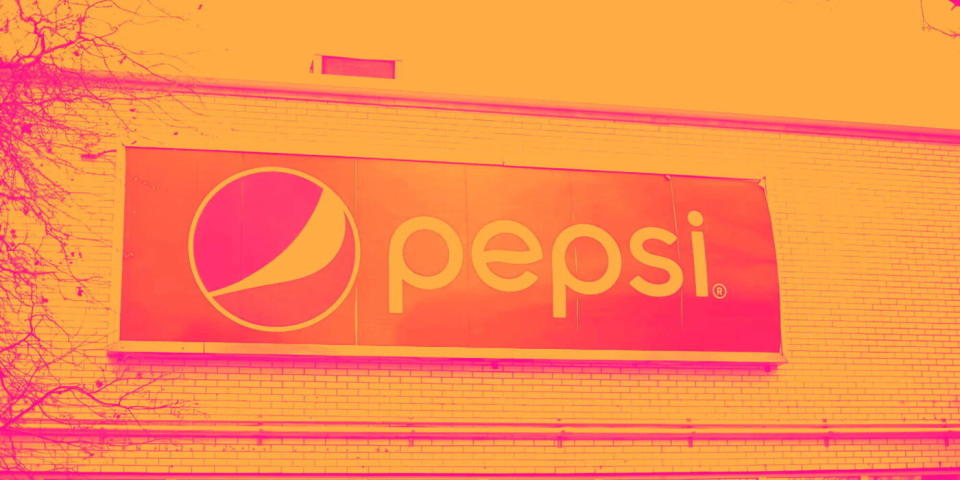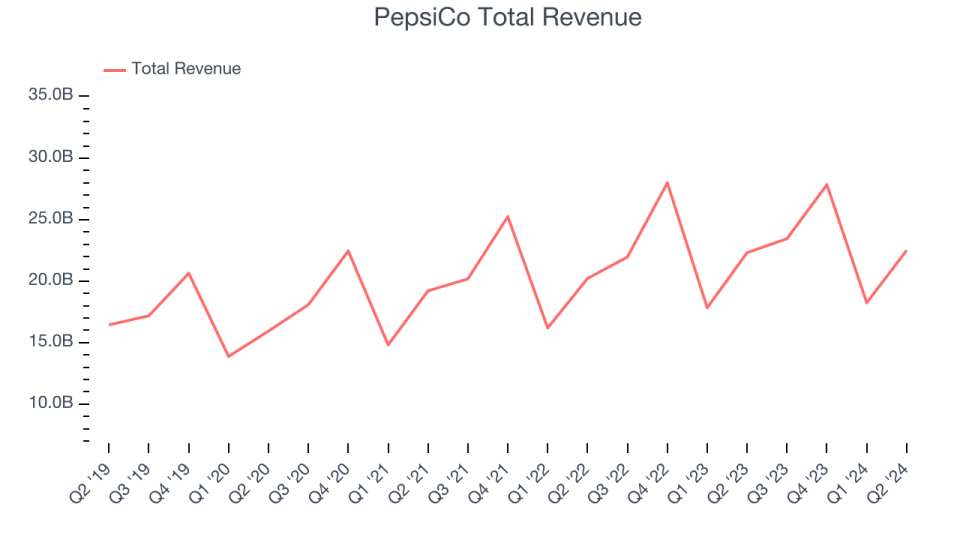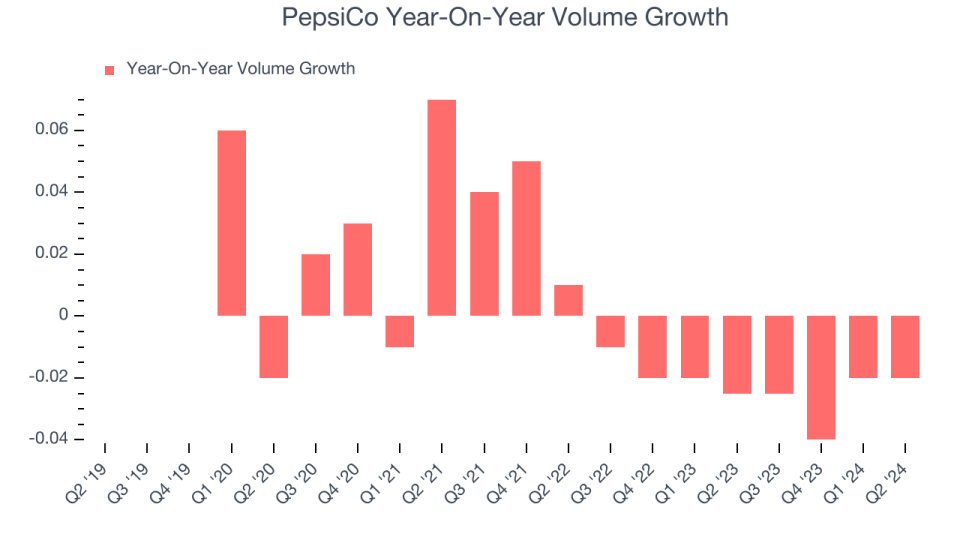PepsiCo's (NASDAQ:PEP) Q2 Earnings Results: Revenue In Line With Expectations

Food and beverage company PepsiCo (NASDAQ:PEP) reported results in line with analysts' expectations in Q2 CY2024, with revenue flat year on year at $22.5 billion. It made a non-GAAP profit of $2.28 per share, improving from its profit of $2.09 per share in the same quarter last year.
Is now the time to buy PepsiCo? Find out in our full research report.
PepsiCo (PEP) Q2 CY2024 Highlights:
Revenue: $22.5 billion vs analyst estimates of $22.59 billion (small miss)
EPS (non-GAAP): $2.28 vs analyst estimates of $2.16 (5.6% beat)
Gross Margin (GAAP): 55.9%, up from 54.7% in the same quarter last year
Free Cash Flow of $1.26 billion is up from -$1.65 billion in the previous quarter
Organic Revenue rose 1.9% year on year (13% in the same quarter last year)
Full year guidance lowered for organic revenue growth (now expect 4% growth, previously "at least 4%")
Sales Volumes fell 2% year on year, in line with the same quarter last year
Market Capitalization: $224.9 billion
With a history that goes back more than a century, PepsiCo (NASDAQ:PEP) is a household name in food and beverages today and best known for its flagship soda.
Beverages and Alcohol
These companies' performance is influenced by brand strength, marketing strategies, and shifts in consumer preferences. Changing consumption patterns are particularly relevant and can be seen in the explosion of alcoholic craft beer drinks or the steady decline of non-alcoholic sugary sodas. Companies that spend on innovation to meet consumers where they are with regards to trends can reap huge demand benefits while those who ignore trends can see stagnant volumes. Finally, with the advent of the social media, the cost of starting a brand from scratch is much lower, meaning that new entrants can chip away at the market shares of established players.
Sales Growth
PepsiCo is one of the most widely recognized consumer staples companies in the world. Its influence over consumers gives it extremely high negotiating leverage with distributors, enabling it to pick and choose where it sells its products (a luxury many don't have).
As you can see below, the company's annualized revenue growth rate of 7.3% over the last three years was decent despite consumers buying less of its products. We'll explore what this means in the "Volume Growth" section.

This quarter, PepsiCo's revenue grew 0.8% year on year to $22.5 billion, falling short of Wall Street's estimates. Looking ahead, Wall Street expects sales to grow 4.4% over the next 12 months, an acceleration from this quarter.
Unless you’ve been living under a rock, it should be obvious by now that generative AI is going to have a huge impact on how large corporations do business. While Nvidia and AMD are trading close to all-time highs, we prefer a lesser-known (but still profitable) semiconductor stock benefitting from the rise of AI. Click here to access our free report on our favorite semiconductor growth story.
Volume Growth
Revenue growth can be broken down into changes in price and volume (the number of units sold). While both are important, volume is the lifeblood of a successful staples business as there’s a ceiling to what consumers will pay for everyday goods; they can always trade down to non-branded products if the branded versions are too expensive.
To analyze whether PepsiCo generated its growth from changes in price or volume, we can compare its volume growth to its organic revenue growth, which excludes non-fundamental impacts on company financials like mergers and currency fluctuations.
Over the last two years, PepsiCo's average quarterly sales volumes have shrunk by 2.3%. This decrease isn't ideal as the quantity demanded for consumer staples products is typically stable. Luckily, PepsiCo was able to offset fewer customers purchasing its products by charging higher prices, enabling it to generate 9.5% average organic revenue growth. We hope the company can grow its volumes soon, however, as consistent price increases (on top of inflation) aren't sustainable over the long term unless the business is really really special.

In PepsiCo's Q2 2024, sales volumes dropped 2% year on year. This result was a further deceleration from the 2.5% year-on-year decline it posted 12 months ago, showing the business is struggling to push its products.
Key Takeaways from PepsiCo's Q2 Results
EPS narrowly outperformed Wall Street's estimates, but organic revenue unfortunately missed analysts' expectations and its revenue missed Wall Street's estimates. The company also lowered its full year organic revenue growth guidance. Previously PepsiCo expected "at least 4% growth", which includes figures higher than this. Now, they expect 4% growth. Overall, this quarter could have been better. The stock traded down 1.8% to $160.75 immediately following the results.
PepsiCo may have had a tough quarter, but does that actually create an opportunity to invest right now? When making that decision, it's important to consider its valuation, business qualities, as well as what has happened in the latest quarter. We cover that in our actionable full research report which you can read here, it's free.

 Yahoo Finance
Yahoo Finance 